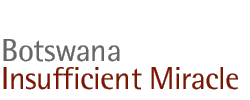Living with HIV (2005)*: 270,000 (24.1% pop.)
Receiving Drugs (2005): 67,000-77,000 (85% of those who need them)
Est. AIDS Deaths (2005): 18,000

Long known as "the African miracle" because of its stable, democratic government, Botswana also has the good fortune to control some of the world's largest diamond mines. Under government control since they were discovered, the mines have brought prosperity to Botswana, but they also have helped spread AIDS.
The diamond industry attracted a mobile workforce: Men left home to work at the mines, where they contracted HIV from sex workers in mining towns, and then brought the infection home to their wives living in villages across the country. As Botswana prospered from the mining, more people moved to large cities for work, and the resulting population migration increased HIV transmission further.
The high rate of HIV infection is devastating to a country with only 1.7 million people. Life expectancy in the early 1990s was 65 years; it's now just 40.
In the late 1990s President Festus Mogae recognized the dire situation and began speaking out, despite the social conservatism that dominates Tswana culture, "We are threatened with extinction. People are dying in chillingly high numbers. It is a crisis of the first magnitude," he said in 2001.
By then, Debswana, the government's partner company with the diamond cartel De Beers, faced rising labor costs due to training replacement workers for employees who either died from AIDS or left to care for sick family. Five years ago, Debswana created a comprehensive HIV/AIDS plan that gave employees antiretroviral drugs, and incorporated prevention and education into the workplace. Free condoms are available in offices and workrooms. Employees are encouraged to know their HIV status (though testing is not mandatory). Today, Debswana requires subcontractors to have workable AIDS policies in place and to offer prevention training and treatment to any worker who wants it.
The stability brought by diamond wealth enabled the government to take the lead in African AIDS treatment. In 2001, Botswana was the first African country to promise free antiretrovirals to its citizens, in partnership with the Merck Company Foundation and the Bill & Melinda Gates Foundation, which each contributed $50 million over five years to the effort.
The program, known as Masa ("dawn" in Setswana) had a slower than expected start, when only people who were almost dead would come to get tested and treated. Today, 2,000 Batswana a month are flooding treatment centers. World Health Organization statistics show that by the spring of 2005, about a third of Batswana with full-blown AIDS were receiving treatment -- roughly 30,000 people. Despite worries from the Western world that African patients couldn't adhere to strict drug regimens, Batswana have shown adherence rates of 90 percent and above -- higher than U.S. patients.
Though Masa is the largest treatment program in Africa, shortages of trained doctors and nurses mean it's impossible to keep up with actual needs, according to Dr. Donald de Korte, the project leader for African Comprehensive HIV/AIDS Partnerships, which helps organize HIV/AIDS efforts throughout the country. "It's mind-blowing," he told The Washington Post in 2002. "We're achieving miracles, and it's totally insufficient."
Despite the terrifying HIV/AIDS statistics and flood of money into Botswana (the government is spending $70 million per year to fight HIV/AIDS, and receives additional money from the Global Fund and PEPFAR, the President's Emergency Plan for AIDS Relief, as well as many other international organizations and pharmaceutical companies), Botswana has had difficulty beginning a frank national conversation about the disease. At funerals people are often said to have died "of a long disease" instead of AIDS. Only a handful of Batswana have publicly announced they are HIV positive. Studies from Uganda, where HIV prevalence has fallen dramatically since the early 1990s, show that the more people talk to each other about HIV/AIDS, the more likely they are to protect themselves from it.
But President Mogae has become more and more vocal about the fight against HIV/AIDS. In 2003, he fell ill and began losing weight. He later told The Boston Globe that he was sure he had AIDS, and tried to prepare himself. He got tested, and announced his negative result publicly -- stress-related diabetes was the diagnosis -- but admitted that he had been afraid. Government ministers now make it a point to address AIDS at every public meeting, no matter what is scheduled for discussion.
Another way Botswana is fighting the epidemic is by switching to switch to an "opt-out" HIV testing program. Begun in 2004, and the only one of its kind, the program makes an HIV test a routine part of any medical visit. Patients can choose not to be tested, but most don't. At a clinic in Francistown, Botswana's second largest city, the percentage of pregnant women who were tested for HIV went from 75 percent in the last four months of the opt-in program to more than 90 percent after the opt-out program began. From 1999 to 2003, only 90,000 HIV tests were done in all of Botswana; in the first six months of 2005, some 74,000 people learned their HIV status.
There are indications that the national response to HIV/AIDS is starting to make an impact on behavior. Minister of Health Sheila Tlou announced in March 2006 that recent statistics show a decline in prevalence, especially in younger age groups. But Botswana has a long way to go. With at least 500,000 people needing treatment in coming years, not even the government's considerable diamond wealth can keep up with health care costs. Botswana will have to depend on more donations from abroad to keep its HIV positive citizens -- most in the prime of their lives -- from dying.
* Note: Figures reflect most recent statistics from UNAIDS and the World Health Organization.
